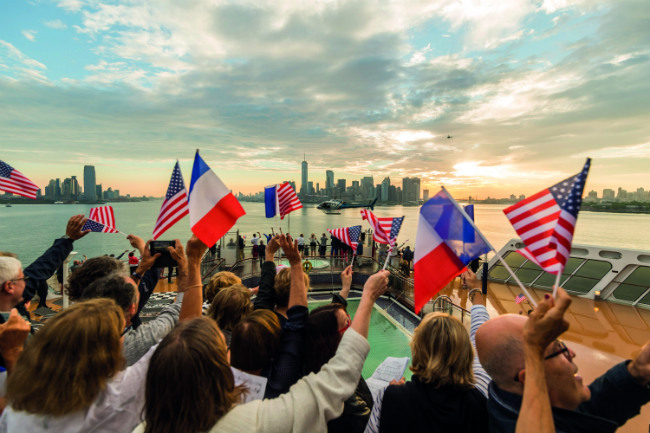The Bridge 2017: The Historic Transatlantic Race Celebrates Franco-American Friendship
It was a race like no other: the Queen Mary 2 against a fleet of giant trimarans, the course retracing the route American forces took in 1917. Precisely 100 years to the day of their arrival in France, Stephen Davy-Osborne stepped aboard Cunard’s iconic ocean liner as she prepared to set sail for NewYork.
June 26, 1917. The first American troops land at Saint-Nazaire, signalling America’s entry into the First World War. By war’s end, more than two million American troops would have made the journey across the North Atlantic to fight alongside the Allies, and consolidate a strong alliance that has stood the test of time.
The centenary of such an important date in the history of Saint-Nazaire required a special celebration – the sort that only a Queen could command. And command it she certainly did. Barely a spot could be found along the quayside as thousands of people lined the dock to welcome home the Queen Mary 2 at the end of June – her first visit home since her launch from this port in 2004.
Here, she took up her position for ‘The Bridge 2017’, an ambitious race across the Atlantic to New York to pay tribute to the soldiers who had laid down their lives in the name of liberty – precisely 100 years after the arrival of the Sammies on the French coast. Racing against her were four elite sailing teams commanding state-of-the-art trimarans.
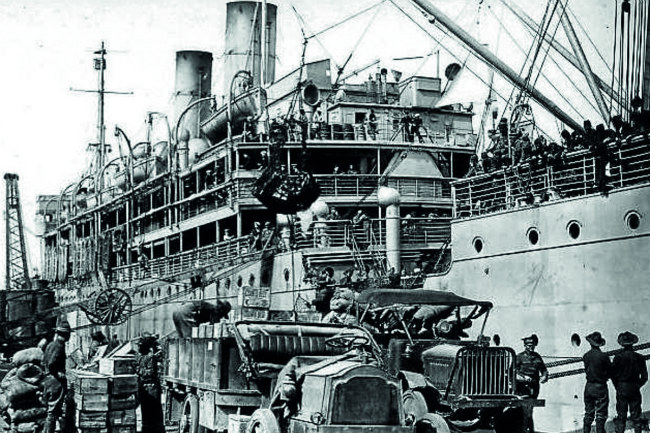
American forces arriving at Saint-Nazaire in 1917. Photo courtesy of The Bridge 2017
The unprecedented challenge was the “mad idea” of offshore sailor Damien Grimont, who dreamed of chartering the ocean-going liner for a commemorative voyage, racing from the spectacular Saint-Nazaire suspension bridge to the Verrazano-Narrows bridge in New York on a journey that would bridge the two nations. But chartering the flagship of the Cunard line and putting her through her paces at the top end of her capabilities was always going to be a tough deal to seal.
“Nobody believed the Queen Mary 2 could be brought back to Saint-Nazaire,” said Damien. “There were technical and emotional challenges involved. With the ship’s 11-metre draught, only an exceptionally high tidal coefficient would allow it.”
But, as luck would have it, the days leading up to the centenary did enjoy an exceptional tidal coefficient, allowing the QM2 to be brought through the Louis Joubert Lock.
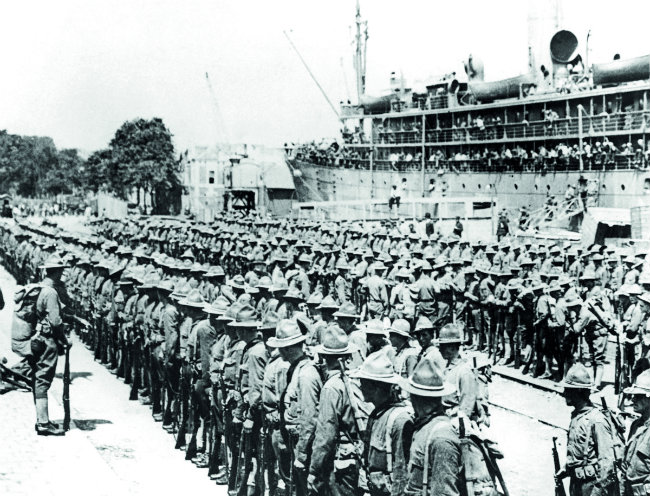
American soldiers in Saint-Nazaire in 1917. Photo courtesy of The Bridge 2017
“When she left the Loire, there was a hope shared by the Cunard Line and the proud population of Saint-Nazaire that she would return one day,” said David Dingle, chairman of the Cunard Line. “I am sure that her return to her port of origin will be engraved in maritime history.”
A festival of celebration was staged around the launch of the event, with two staples of North American culture that had travelled across the Atlantic with the soldiers – jazz music and basketball tournaments – taking centre stage.
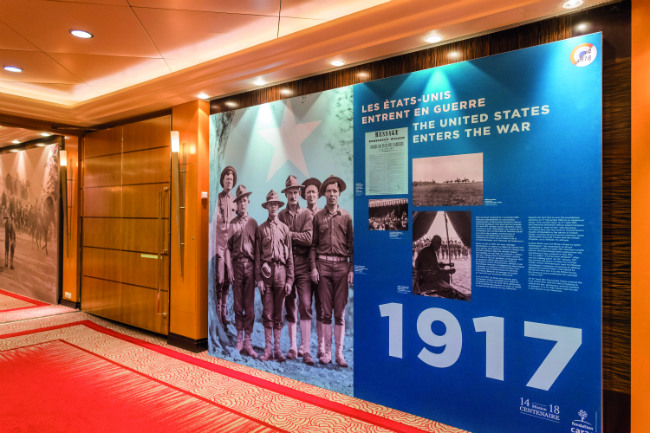
A presentation on the ship explains the events of 100 years ago. Photo: Stephen Davy-Osbourne
THE MONARCH OF THE SEAS
The very next day after her arrival in Saint-Nazaire the monarch of the seas gracefully slipped out of her berth into the Loire estuary, with her sights firmly set on New York. Watched on by thousands of people who had come to wave her off, she took her place alongside the four ‘ultimate’ trimarans – each over 81 feet – to compete in the special race.
Over the following week the skippers and their crews had to draw on all their seafaring skills and tactical nous to overcome the challenges of the Atlantic in a bid to be the first to dock in New York. With the weather on their side, the trimarans hoped to have an edge on the world’s largest ocean liner, although it was home water for the QM2, which cruised at her top speed throughout the 3,152-mile journey.
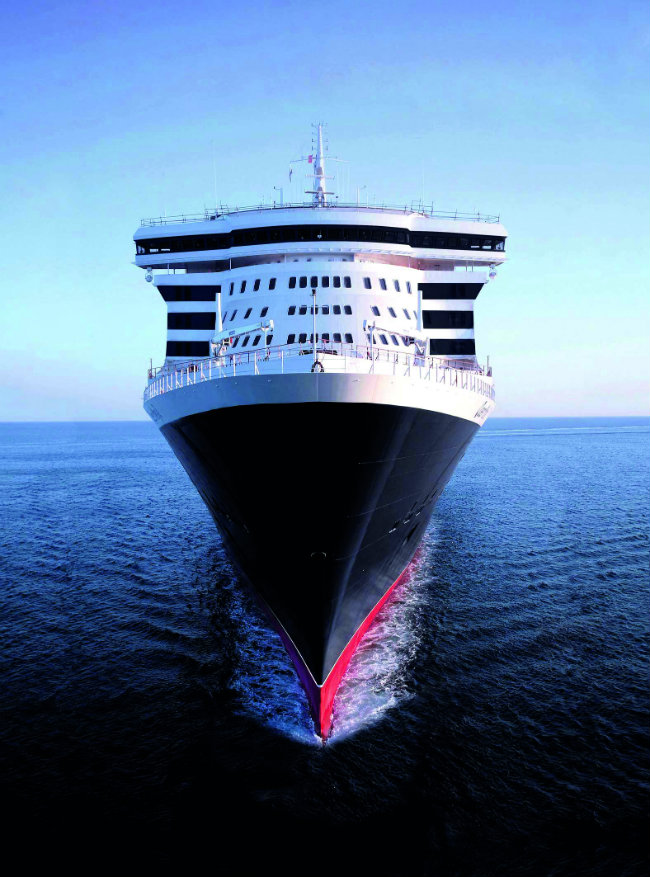
courtesy of The Bridge 2017
Up against her was Francis Joyon, skippering IDEC Sport. Joyon is the holder of the Jules Verne Trophy for the round the world record with a crew – 40 days, 23 hours. He was competing against the holder of the round the world solo record, Thomas Coville, who circumnavigated the globe in just 49 days and 3 hours, taking the title from Joyon. For the Bridge he was again at the helm of Sodebo Ultim.
Captaining Macif was François Gabart, who at 34 was the race’s youngest skipper – but who already has the title of winner of the 2016 Transatlantic Race under his belt. A familiar face to him was the bronze medallist from that event, Yves Le Blevec. Regarded as among the nest experts in leading a trimaran at full speed, Le Blevec commanded Team Actual.
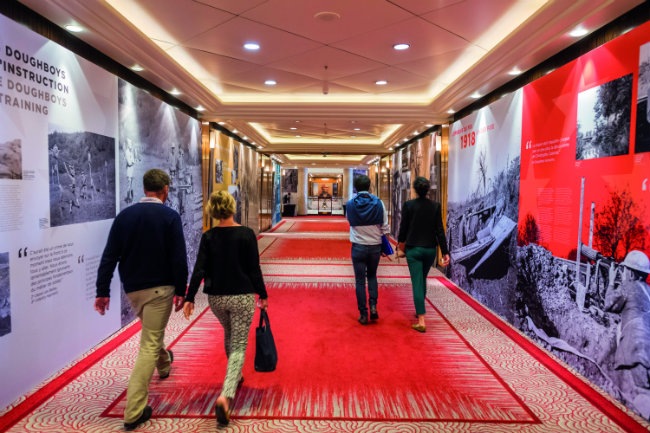
Passengers aboard the ship. Photo: Stephen Davy-Osbourne
STEALING THEIR THUNDER
Somewhat stealing their thunder though – and dwarfing their impressive triple hulls – was the Cunard Queen, marking a poignant return to port where she was built in 2003 before her launch as Cunard’s flagship in January 2004 to become the cruise line’s only transatlantic vessel.
But even her presence was outdone by the celebration in the skies above her 13 decks and iconic red funnel. With reworks launched from Saint-Nazaire Bridge, a brand new Airbus A380 soared down over the estuary before looping back around to signal the start of the race – to applause and cheers from everyone on the dock and on the deck.
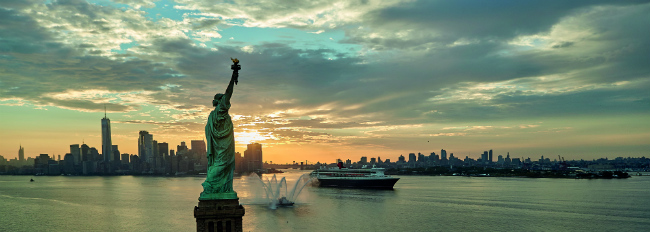
The Queen Mary 2 reaches her destination. Photo: The Bridge 2017
After a busy week at sea, the iconic ocean liner docked in New York on Saturday, July 1 at 11.45am French time, having completed the journey in five days, 16 hours and 45 minutes, shaving an entire day off a typical transatlantic crossing. The first trimaran would not arrive for another three days.
Arriving before dawn, a chorus of 100 singers, conducted by Jean-Christophe Spinosi, took to deck seven at the stern of the ship to sing Amazing Grace as the sun rose over the skyscrapers of the Big Apple in a celebration of a really rather remarkable journey.
“It seems to me vitally important to remember the values of kinship which united the two countries and which has advanced the rights and freedoms of both,” The Bridge’s creator and organiser Damien Grimont said. “There is also a sense of magic and wonder in The Bridge 2017. A battle between the most prestigious liner and the biggest multihulls really fires the imagination. With this event, we can prove that it’s possible to do beautiful things and see crazy dreams come true. We bring a little lightness and optimism to a very harsh world.
“I would highlight the project’s ability to bring together people from all walks of life: sailors, artists, basketball players, and entrepreneurs. All together we can build on the past to build the future.”
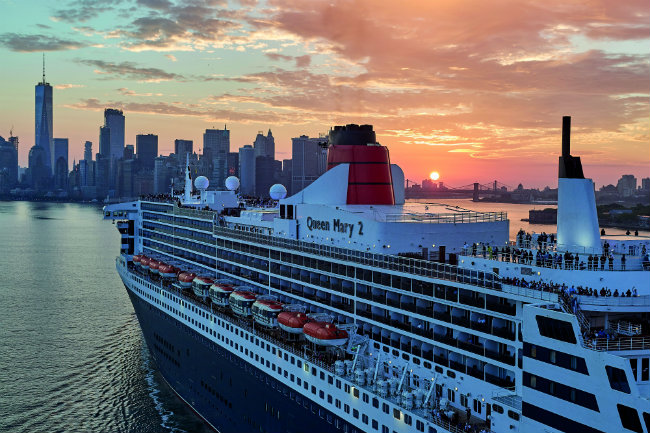
Courtesy of The Bridge 2017
SIDEBAR: SAILORS’ STORIES
THE NAVIGATOR: For Samantha Davies the race was unforgettable in more ways than one. As the crowds lined the harbour walls of Saint-Nazaire and the decks of the QM2 to see the boats cross the start line, Davies, the navigator on board the 30-metre trimaran Actual, and the four other crew members, had to perform a last-minute manoeuvre to avoid being run over by their vast competitor. “At the time we didn’t have time to take the whole thing in,” she said. “It’s actually quite stressful sailing these machines in a very confined space, because the big trimarans are more designed to be sent across the Atlantic than short tack in a river with a huge liner. We had quite a close call with them just off the start line and had to tack with a bit urgency to get away from being run down by the Queen Mary 2. It was quite stressful, but a once-in-a-lifetime experience and I don’t think I’ll ever forget that.”
THE SKIPPER: None of the skippers needed reminding of just how tough the North Atlantic could be though, not least Chris Wells, the captain of the QM2. Just two weeks prior to her departure from Saint-Nazaire, the QM2 diverted off her course to rescue a stricken solo skipper competing in the OSTAR transatlantic race. Mervyn Wheatley, a 73-year-old ex-Royal Marine from Newton Ferrers competing in the race for the fifth time, was taking on water through a smashed port hole after his 38-footer, Tamarind, was knocked at in 60 knot winds and 15-metre waves. When the QM2 arrived to save him he had to scupper his yacht to avoid it being a danger to other shipping.
Related articles:
The Bridge 2017: The Queen Mary 2 Arrives in New York
The Bridge 2017: A Historic Transatlantic Race Starring Queen Mary 2
From France Today magazine
Share to: Facebook Twitter LinkedIn Email
Leave a reply
Your email address will not be published. Required fields are marked *

